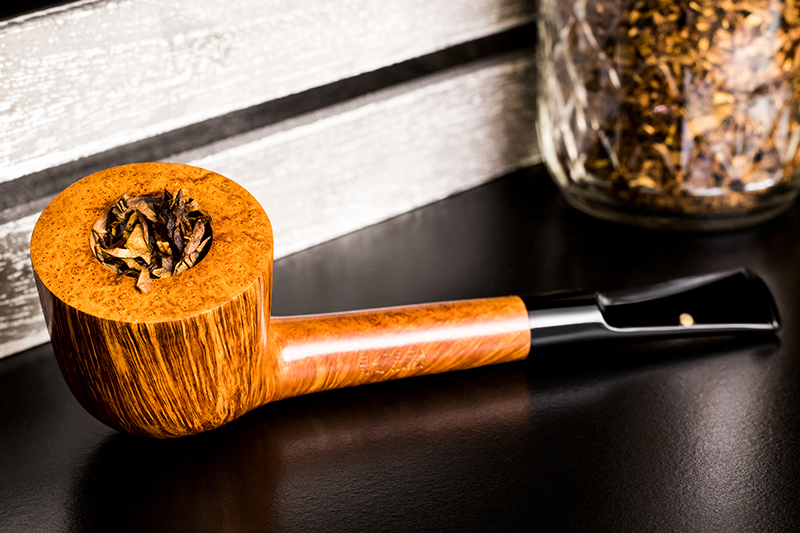
Tongue bite! Problem among pipe smokers
"Tongue bite" is an accurate descriptor for the condition, which can feel like clamping your tongue in a super-heated, coil-spring wolf trap. Tongue bite is the condition most probably responsible for causing new pipe smokers to quit before learning the simple techniques for avoiding it and the pleasurable smoking experiences on the other side. It makes pipe smoking unpleasant, and few will find success if it persists.
Trial and error without advice can be a slow way to learn. If you're experiencing tongue bite, the following information will help you understand what causes it, and achieve the pain-free and pleasant activity that pipe smoking should be.
Two Kinds of Tongue Bite
Tongue bite arises in two varieties: temperature and chemical (meaning disagreeable pH levels of relative acidity or alkalinity), but most often they combine for admirable efficiency in making our lives temporarily miserable. Temperature-bite is probably the first type we experience, and it occurs most often because our pipes are improperly loaded and our tobaccos are too moist.
Most tobaccos emerge from their packaging with more moisture content than is easily smoked, but we don't know that when we're lighting our first-ever bowl. It's intuitive to think that tobacco in the tin manifests its most smokable composition, but that's not always so. The moisture is necessary to protect the product, especially in its more delicate forms like flakes or coins. It's more fragile when dry, is subject to breakage, and can lose flavor as its constituent compounds break down with evaporation.
Many seasoned and skillful smokers prefer moist tobaccos. Flavor travels from the tobacco to our taste buds primarily via moisture in the smoke, but one of the special characteristics of pipe smoking is adjustability, and reducing the moisture content modulates the likelihood of tongue bite and makes the pipe easier to keep lit and smoke dryly. Everyone experiments to find their sweet spot regarding tobacco moisture and the way it delivers the flavors of different tobaccos. If the tobacco is too dry, it will have lost flavor and will burn too quickly and too hot, like dry kindling. If the tobacco is too wet, it will again burn hot because excessive heat is necessary to transform that moisture into smoke and vapor, possible only with ambitious puffing that further increases heat.
o Temperature Bite
That's where tongue bite can ambush us with its scorching dragon's breath. With wet tobacco, aggressive puffing is needed to keep it smoldering, raising the temperature of the smoke. Like the tobacco, that smoke contains more moisture than is best, which can more efficiently store heat as it migrates from the bowl to the mouth. We're familiar with the way large bodies of water retain temperature beyond their environments, and that concept works on a micro-scale as well. In extreme cases, the heat necessary for the combustion of overly moist tobacco can even stress the briar and compound the possibility of burn-out. But before that happens, tongue bite will mock and discomfit us, and motivate us to pause and rethink our life choices.
In converting water in the tobacco into heat, smoke, and vapor, we subject our tongues to wet and very hot smoke. It isn't steam, which is 100°C (212°F), but it takes much less heat than that to deliver discomfort, and it takes little time for our tongues to protest. The most sensitive part of the tongue, the tip, can withstand temperatures of 45°C (113°F) for about five minutes before experiencing physical burning sensations, and the tissue will be more immediately burned at 47°C (116.6°F). That's much less than the temperature of steam, but it indicates that water vapor needn't be superheated to deliver aggravation. Although that temperature seems moderate when compared to, say, coffee or tea, which are served at about 70°-80°C, the circumstances are dissimilar. Different parts of the tongue are differently affected by heat, with the tip being most sensitive, and when we drink a hot beverage we avoid contact with the more delicate parts of the tongue, take small sips, and manipulate the liquid to avoid prolonged contact with any one area.

o Chemical Bite
The second category of tongue bite is chemical, caused by unbalanced pH. No one knows why it's called pH. The concept was introduced by Danish chemist Søren Peder Lauritz Sørensen in 1909 as a measurement of potential difference in the concentration of hydrogen atoms in a solution. The "pH" may stand for power or potential of hydrogen, part of the equation for comparing and measuring the acid or base consistency of a substance. The range of measurement is from 0 to 14. Seven is neutral; below 7 indicates acidity, and above 7 is base, also called alkalinity.
Another consideration is that nicotine is absorbed by the buccal mucosa in our mouths more efficiently with higher relative alkalinity. Cigars, for example, possess higher pH than cigarettes and deliver more nicotine in the mouth, whereas the nicotine in cigarettes is released in the lungs only after its pH changes to more alkaline. So the perceived strength of tobacco is partially a function of pH.
Beverages enjoyed while smoking affect nicotine absorption according to their pH; unsweetened tea, for example, is relatively alkaline and will increase nicotine absorption more than, say, Coca-Cola, which is acidic at about 2.7. Soft drinks like Coke are generally considered uncomfortable for pipe smoking because of the tingling that accompanies carbonation as well as an acidic pH.
The numbers scale logarithmically, so if something has a pH of 9, for example, it's 10 times more alkaline than 8, and 10 is 100 times more. Battery acid has a pH of less than 1; orange juice is between 3 and 4; water is 7.4, bleach is 12.5. Honey, a popular tobacco flavoring constituent, is between 3.5 and 5.5, helping to balance blends that would otherwise fall on the side of alkalinity.
Saliva is between 6.2 and 7.6, which accounts for the different results experienced by different smokers. The closer we can match the pH of tobacco smoke to our own natural mouth pH, the more comfortable it will be. Since we all have slightly different mouth pH, which can be affected by what we drink or eat as well as by our individual body chemistries, we all perceive the balance of tobacco blends slightly differently.
In terms of tobacco blends, pH is difficult to determine because casings and toppings alter the pH. That's among the main reasons for their use, in fact: toppings contribute to flavor and mouthfeel but they also adjust pH. By itself, Virginia tobacco has a pH in the vicinity of 5.5, depending on sugar content and other factors. Oriental is around 5.0. Burley is 5.8-7.0 or more, depending largely on the pH of the soil where it grew, which affects all tobacco. These numbers are difficult to confirm and sources are few. There's some variance to accept.
Any pH that strays far in either direction from the 6.7 average of our mouths, which is slightly less than neutral, can cause discomfort, and the farther from neutral it is, the more uncomfortable prolonged contact can be.
How to Soothe Tongue Bite
A low-pH beverage or snack can counter the alkalinity of some blends. Smokers have reported success with Biotene mouthwash, which has a pH of 4.6, as well as honey (3.4-5.5); red wine (3.3-3.6); dark chocolate (5.5-5.8); tea (4.0-6.0, with green tea and ginger tea being lowest); and coffee (with a pH of about 5).
Certainly chocolate and honey are soothing for the temperature-burn aspect of tongue bite, and they also help to adjust the disparity in relative pH that contributes to the discomfort. However, sipping a beverage of your choice will be important. Since we all have slightly different body chemistries, a little experimentation will be necessary. Try water, try coffee, tea, whatever appeals to you, and pay attention to how well it alleviates any tingling tongue adversity.

Eliminating Tongue Bite
The basic steps to banishing tongue bite forever are simple, but some require a little practice and experimentation:
- Dry your tobacco. Experiment to find the proper humidification for excellent flavor transfer while keeping moisture to a minimum. This is the single most useful tip for avoiding tongue bite.
- Load your pipe just right, in the Goldilocks zone: not too tight; not too loose.
- Practice proper tamping technique. Tamping keeps each level of burning tobacco in contact with the next and permits ongoing combustion, but tamping too hard will compress the tobacco and raise heat and air resistance, so observe the draw characteristics as you progress to find just the right pressure.
- Puff slower. Sipping tobacco smoke in a leisurely fashion, with pressure similar to sipping soda through a straw, provides the best flavor and drastically reduces the likelihood of tongue bite.
- Try aging your tobaccos, especially Virginia blends. Aging a tin for a couple of years will make a blend more mellow as its starches break down and transform into more flavorful and cooler-smoking compounds.
- Drink a beverage while smoking, most often something neutral like water or something slightly acidic to balance the alkalinity of the tobaccos that most often generate bite.
- Try other blends. English blends are the most forgiving and comfortable to smoke, but with good technique, high-sugar straight Virginias and highly flavored Aromatics can be enjoyed without issue.
- Keep the pipe clean and its airflow clear. Don't let moisture build in the pipe. Run a pipe cleaner through it when you sense higher humidity in the smoke or start to feel the onset of gurgle in the pipe. Pipe cleaners also clear any tobacco particles that may become lodged where the draft hole enters the heel of the tobacco chamber. Restrictions in airflow cause more aggressive puffing and higher heat.
- Prepare for the use of more pipe cleaners and even slower smoking in humid environments.
- Use low-heat ignition sources.
Tongue bite is responsible for dissuading many new pipe smokers from pursuing what is among the most relaxing and enjoyable pastimes that we can experience. Pipe smoking has provided comfort, meditation, and relaxation for millions of enthusiasts over hundreds of years and is worth pursuing, but no one can advance comfortably without first learning how to beat tongue bite. Experimentation is necessary, but knowing the factors involved and the specific causes of tongue bite will accelerate progress. Practice the advice gathered here and look forward to decades of smoking satisfaction.
Please consider providing your own strategies, tips, favorite beverages, and general tongue-bite solutions in the comments below. We all benefit from the experiences of others.
Chuck Stanion.(August 19, 2022). Tongue Bite: A Comprehensive Guide for Pipe Smokers. https://www.smokingpipes.com/smokingpipesblog/single.cfm/post/tongue-bite-comprehensive-guide-for-pipe-smokers
